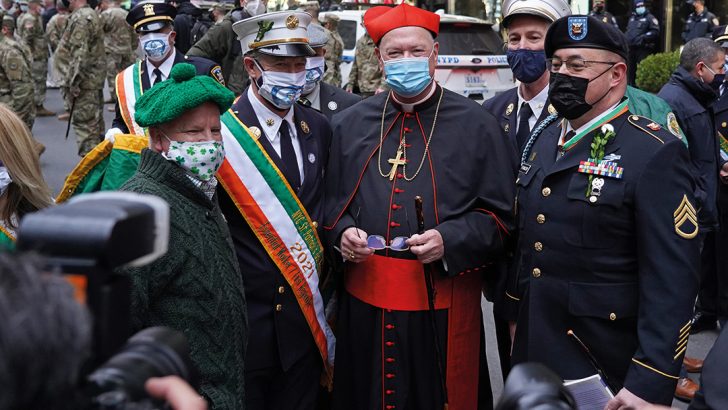Irish lives in America Edited by Liz Evers and Niav Gallagher (Royal Irish Academy, €19.95/£18/$25)
On this day every year Irish thoughts turn without fail to our relatives and friends in the United States. In reciprocation, President Joe Biden has this year issued a special proclamation from the White House declaring March 2022 as Irish-American heritage month. This compact book explores that heritage.
The book gathers together entries from the Dictionary of Irish Biography for some 50 Irish-Americans, all of them first-generation immigrants. Eighteen are women. The earliest subject is James Logan, public servant and scientist in pre-independence America, born in Co. Armagh in 1674; the latest is actress Maureen O’Hara – born in Dublin in 1920, died in 2015 and buried in the fabled Arlington National Cemetery outside Washington, D.C.
Published
All the entries, except two, have been previously published and – like every other entry in the Dictionary of Irish Biography – are available to read for free on the website of the Royal Irish Academy, the publisher of this book. In these circumstances, the raison d’être of the book is not immediately obvious.
The book may possibly be intended to boost Irish-American identity, not now as strong as it once was. The fact that the present Irish ambassador to the United States, Daniel Mulhall, has contributed a foreword to it seems to confirm that. If so, the book is a very incomplete survey of Irish-American lives – no JFK, no Grace Kelly and no other Irish-American of the second or subsequent generations. The rule for inclusion in the Dictionary of Irish Biography is that one must have been born in Ireland and/or had a career in Ireland. The fact that this book is derived from the dictionary limits its scope.
Foreword
As Ambassador Mulhall points out in his foreword, the outstanding Irish-American in the book is Thomas Francis Meagher – memorialised as ‘Meagher of the Sword’. He notes that Meagher was “an important figure on both sides of the Atlantic”.
Another important figure on both sides of the Atlantic was Meagher’s contemporary and fellow Young Irelander, John Mitchel. Mitchel is not, however, included. Have we disowned him because he defended slavery and supported the Confederacy during the American Civil War? Has the Royal Irish Academy succumbed to the ‘cancel culture’ phenomenon?
Another discreet omission is ‘Boss’ Croker of Tammany Hall, born in Co. Cork in 1841. He is also someone we are loath to claim as an archetypical Irish-American.
Omission
A surprising omission is John Hughes, born in Co. Tyrone and the first Archbishop of New York, who founded St Patrick’s Cathedral on Fifth Avenue (one of the greatest churches in Christendom, and my favourite) and who, in addition, was sent by President Abraham Lincoln as an envoy to Paris and Rome during the American Civil War to promote the Union cause. There are, in fact, only two Catholic religious personages in the book: Fr Patrick Payton, the ‘Rosary priest’; and Sr Anthony (née Mary O’Connell, from Co. Limerick), known as ‘the Florence Nightingale of America’ for her work in field hospitals during the Civil War.
Most of those that one would expect to find in this book are, of course, in it. Examples are: James Hoban, architect of the White House; journalists Mathew Carey and John Boyle O’Reilly; Annie Moore, the first immigrant to land on Ellis Island; ‘Mother’ Jones, labour activist; Maeve Brennan, writer and columnist with The New Yorker; and tenor John McCormack, who annoyed some of his fans by becoming a naturalised American citizen in 1919.
Obscure
Of the more obscure people featured in the book, perhaps the most intriguing is Margaret Maher who worked as a domestic servant for the wealthy but eccentric Dickinson family in Amherst, Massachusetts, and is credited with preserving the poems of the eldest daughter of the family, Emily Dickinson, after her death in 1886. Maher refused to burn them as Emily had instructed.
Curiously, two of the women who appear in the book were included in a set of stamps issued by An Post in 2020 honouring ‘pioneering Irish women’. One was Maureen O’Hara; the other was Carmel Snow, a native of Dalkey, Co. Dublin, and editor of Harper’s Bazaar in New York from 1935 to 1957. Her entry records “her love of a three-martini lunch”, illustrating how fully she had embraced the mores of her adopted country.
One imagines that this book will provide our Government ministers with an agreeable gift for presentation to local dignitaries in the scattered US cities they visit for St Patrick’s Day celebrations this year.


 New York Cardinal Timothy Dolan poses for a photo prior to celebrating the St Patrick’s Day Mass at St Patrick’s Cathedral in New York City in 2021. Photo: CNS
New York Cardinal Timothy Dolan poses for a photo prior to celebrating the St Patrick’s Day Mass at St Patrick’s Cathedral in New York City in 2021. Photo: CNS 
